Turtle Exclusion Devices
-
- Fisheries Technology for Resource Management Marine Technology, May 2014 #36
The U.K. alone has 6,400 fishing vessels, with total landings of fish catch equating to $1.3 billion (627,000 tons) in 2012 (1). Despite warnings of a slowdown in the marine catch in the 1970s and 80s, the fishing industry increased fishing efforts with more powerful boats as well as superior technology, allowing the tracking of fish populations with sonar devices and larger nets to increase catch size. In addition, the international commercial fishing industry is double the size necessary to meet current requirements, and overcapacity is now a global norm. The European Union itself is in 40% overcapacity, resulting in fierce competition and difficulties in mitigating impacts with higher percentages found around the globe (2).
The Problem
Although overexploitation of fishing resources is the main issue, wasteful practices which resort in by-catch or discard is an area necessitating much focus by resource management schemes. By-catch has long been recognized as a widespread issue, with around 25% of total catch being discarded back into the sea dead due to little or no commercial value (3). This equates to approximately 27 million tons, the equivalent of 600 fully-laden Titanics (4).
The impact of by-catch to the ocean ecosystems is not only colossal but often irreversible (5). The different types of commercial fishing practices result in variations of species and quantities being killed as by-catch: nets kill cetaceans, long-line fishing kills birds and bottom trawling devastates marine ecosystems (5).
oShrimp fisheries are renowned to be inefficient and ecologically damaging, with often more than 80% of a catch comprising marine species other than shrimp which gets discarded (5). Bottom-trawling and beam-trawling, removes up to 20% of the seafloor fauna and flora in a single trawl, in addition to by-catch of commercially unattractive animals (5).
By-catch occurs due to fishing gears inability to adequately select target species, the problem worsened by economic pressures resulting from overexploitation (3). A large majority of by-catch is discarded due to fishing quotas minimizing landings (size of catch) and when regulatory restrictions prohibit retention of particular attributes (size, species, sex) (3, 5). Therefore, some by-catch occurs in commercial fisheries, however, higher rates are found in fisheries with less selective fishing methods and practices. Mitigating the environmental impact of commercial fishing by avoiding, minimizing and compensating for adverse effects, is fundamental for fisheries management authorities worldwide (6). The complex interplay of ecological, economic, and social considerations has often resulted in by-catch management being reactive, confrontational and costly (6). Some by-catch species, including fish, reptiles, birds and mammals, may be threatened with extinction (3). Even Tuna fisheries, which in the past had high dolphin by-catch levels, are still responsible for the deaths of an estimated one million sharks annually (5). Around the U.K., evidence of the growing scale of by-catch is washed up on beaches around the south west of England and northern France annually in the form of dolphin and porpoise corpses.
Progresses in technology for impact reduction has not been as quickly established as technologies designed to increase overall catch. Although modifications to fishing gear or practices have offered an effective means of reducing by-catch, such as turtle exclusion devices and Pingers, these devices need continual monitoring and in many cases it has been difficult to demonstrate success (3, 6). Therefore effective use of these devices depends on overcoming gear handling constraints and the short-term economic losses often associated with their use (3).
The Solution
The Icelandic high technology company Star-Oddi has developed revolutionary equipment that filters out the majority of unwanted by-catch, (up to 75% of the by-catch). The Fish Selector, which is an equipment that automatically separates the fish while still in the trawl, means that discarding of fish by fishing companies could be a thing of the past.
The aims of using Fish Selector are to increase the value of the catch, avoid discard of fish and increase fishing efficiency by helping with decision making for the skipper of selecting a fishing area. In addition to benefitting the commercial fisheries companies the marine research institutes may find scientific value in using the equipment in their studies.
The Fish Selector is placed in front of the cod-end and as the fish swim through the device it is pre-programmed to select fish by specific size and species so those that are not intended for landing, are sorted out and directed away through a bypass gate. Collected information is wirelessly monitored in real-time in the bridge on the quantity of fish caught, as well as quantity bypassed. Other data can be collected such as depth, temperature and inclination.
Data on how many fish are caught and how many are released is automatically stored and sent in real time onboard the vessel. Collected information on quantity of caught fish and bypassed fish can be viewed wirelessly by the crew. The data gives insight into the quality of the fishing ground so the skipper can quickly and better estimate if fishing should continue or if movement to a different area would be beneficial. The emphasis on responsible and sustainable fisheries has been increasing. Fishing companies using the Fish Selector can help in delivering the message to consumers that the company is making its contribution to sustainable fisheries by releasing threatened species.
Field Testing
In December 2010 the Fish Selector was tested on the research ship Drofn. It operated very well on its first sea trial. Since then, focus has been on reducing the size of the equipment which will give the fishermen the following advantages:
Takes less deck space
Smaller volume and weight decreases hazards associated with having bulky equipment on deck
Fishermen can more easily move the equipment around and the smaller device is then carried by two operatives
Smaller volume and lower weight will make it easier to take the device onto smaller ships, increasing the market potential
First Prize Innovation Award for the Fish Selector
Star-Oddi won first prize for the most innovative technology for the fishing industry at the Icelandic Fisheries Conference. The conference was held for the fourth time in November 2013. People from fishing companies, state officials and scientists attend this conference. The goal of the award is to encourage creative thinking and innovation in the fisheries sector.
About Star-Oddi
Star-Oddi (Iceland) develops research equipment for increasing the knowledge on marine life and underwater environments. Star-Oddi specializes in the design and manufacture of scientific equipment, mainly miniature data loggers containing microelectronics and sensors for monitoring behavioral and environmental parameters such as salinity, temperature, depth, tilt angle and more. The miniature self-contained loggers are used for behavioural studies of fish as well as on moorings and nets.
References
(1) Overview of the UK fishing Industry (2013). Retrieved from Marine Management Organization website: www.marinemanagement.org.uk/fisheries/statistics/annual.htm
(2) World Fisheries: Declines, Potential and Human Reliance (April, 2006). Retrieved from the University of Michigan website: www.globalchange.umich.edu/globalchange2/current/lectures/fisheries/fisheries.html
(3) Cook, R. (2003). The Magnitude and Impact of By-catch Mortality by Fishing Gear. In M. Sinclair & G. Valdimarsson (Eds.), FAO. Responsible Fisheries in the Marine Ecosystem.
(4) Threat 1: Overfishing (n.d.). Retrieved from Save Our Seas Foundation website: saveourseas.com/threats/overfishing
(5) Bycatch – wasteful and destructive fishing (n.d.). Retrieved from Greenpeace website: www.greenpeace.org.uk/oceans/problems/bycatch-wasteful-and-destructive-fishing
(6) Kirby, S.K., Ward, P. (2014). Standards for the effective management of fisheries bycatch. Marine Policy, 44, 419-426
(As published in the May 2014 edition of Marine Technology Reporter - http://www.marinetechnologynews.com/Magazine)
-
 )
March 2024 - Marine Technology Reporter page: 11
)
March 2024 - Marine Technology Reporter page: 11assist in identifying mines and act as a neutralization device. About the Author Bottom mines pose even greater chal- David R. Strachan is a defense analyst and founder of lenges. Unlike contact mines, bottom Strikepod Systems, a research and strategic advisory mines utilize a range of sensors to
-
 )
April 2024 - Maritime Reporter and Engineering News page: 43
)
April 2024 - Maritime Reporter and Engineering News page: 43“The industry is an ecosystem which includes owners, managers, mariners, shipyards, equipment makers, designers, research institutes and class societies: all of them are crucial,” – Eero Lehtovaara, Head of Regulatory & Public Affairs, ABB Marine & Ports All images courtesy ABB Marine and Ports provi
-
 )
April 2024 - Maritime Reporter and Engineering News page: 13
)
April 2024 - Maritime Reporter and Engineering News page: 13from gasoline to methanol, but compared to just buying an EV After some pondering, I think I can reduce it to this logi- today that is a pointless exercise. It would actually make more cal sequence: sense to buy a plug-in hybrid that is con? gured for methanol It is the carbon. We want zero carbon as
-
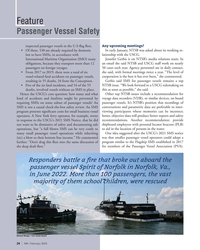 )
February 2024 - Marine News page: 24
)
February 2024 - Marine News page: 24Feature Passenger Vessel Safety Any upcoming meetings? inspected passenger vessels in the U.S-? ag ? eet. • Of these, 530 are already required by domestic In early January, NTSB was asked about its working re- law to have SMSs, in accordance with lationship with the USCG. International Maritime
-
 )
January 2024 - Marine Technology Reporter page: 18
)
January 2024 - Marine Technology Reporter page: 18TECH FEATURE WAVE POWER All images courtesy Mocean Energy MOCEAN ENERGY AIMS TO CREATE AN OFFSHORE RENEWABLE MICROGRID Garnering power from ocean waves is a generation behind the progress of offshore wind, but Mocean Energy, led by founder and managing director Cameron McNatt, is aiming to help offshore
-
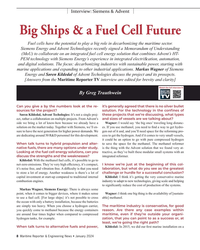 )
January 2024 - Maritime Reporter and Engineering News page: 8
)
January 2024 - Maritime Reporter and Engineering News page: 8Siemens Energy Big Ships & a Fuel Cell Future Fuel cells have the potential to play a big role in decarbonizing the maritime sector. Siemens Energy and Advent Technologies recently signed a Memorandum of Understanding (MoU) to collaborate on an integrated fuel cell energy solution that combines Advent’s
-
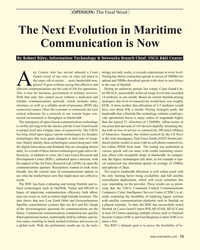 )
November 2023 - Maritime Reporter and Engineering News page: 73
)
November 2023 - Maritime Reporter and Engineering News page: 73OPINION: The Final Word The Next Evolution in Maritime Communication is Now By Robert Riley, Information Technology & Networks Branch Chief, USCG R&D Center ny Coastie who has served onboard a Coast nology not only works, it exceeds expectations at every level. Guard vessel of any size, or class can
-
 )
November 2023 - Maritime Reporter and Engineering News page: 70
)
November 2023 - Maritime Reporter and Engineering News page: 70In the Shipyard Latest Deliveries, Contracts and Designs Marcelle Melosira: Hybrid Research Vessel Derecktor Shipyards NY in Mamaroneck, N.Y. has deliv- tion with UVM and Chartwell, the 64-foot research catamaran ered a new hybrid research catamaran to the University of has been crafted to ful? ll the
-
 )
November 2023 - Maritime Reporter and Engineering News page: 31
)
November 2023 - Maritime Reporter and Engineering News page: 31WAVE DATA & SHIP DESIGN data gap ready to be drastically reduced through Bristlemouth, “By applying the ? rst open ocean connectivity standard. A collaboration be- accurate weather tween Sofar and strategic partners in the public and private sector, Bristlemouth delivers plug-and-play hardware inter- for
-
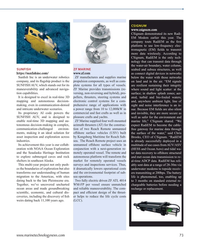 )
September 2023 - Marine Technology Reporter page: 73
)
September 2023 - Marine Technology Reporter page: 73CSIGNUM www.csignum.com CSignum demonstrated its new Radi- EM Modem earlier this year. The company touts RadiEM as the ? rst platform to use low-frequency elec- tromagnetic (EM) ? elds to transmit more data wirelessly. According to CSignum, RadiEM is the only tech- nology that can transmit data through
-
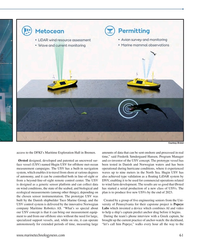 )
September 2023 - Marine Technology Reporter page: 61
)
September 2023 - Marine Technology Reporter page: 61Courtesy Ørsted access to the DFKI’s Maritime Exploration Hall in Bremen. amounts of data that can be sent onshore and processed in real time,” said Frederik Søndergaard Hansen, Program Manager Ørsted designed, developed and patented an uncrewed sur- and co-inventor of the USV concept. The prototype
-
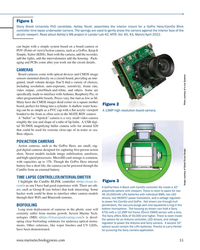 )
September 2023 - Marine Technology Reporter page: 55
)
September 2023 - Marine Technology Reporter page: 55Figure 1 Stony Brook University PhD candidate, Ashley Nicoll, assembles the interior mount for a GoPro Hero/CamDo Blink controller time lapse underwater camera. The springs are used to gently press the camera against the interior face of the acrylic viewport. Read about Ashley’s MS project in Lander Lab #2
-
 )
September 2023 - Marine Technology Reporter page: 50
)
September 2023 - Marine Technology Reporter page: 50MTR 100 Silicon Sensing www.siliconsensing.com Silicon Sensing Systems Ltd is a leader in silicon MEMS gyroscopes, accelerometers and inertial mea- surement systems, focusing on products delivering high performance, ultra-reliability with affordability. The com- pany has supplied more than 25 million
-
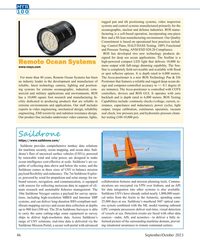 )
September 2023 - Marine Technology Reporter page: 46
)
September 2023 - Marine Technology Reporter page: 46MTR 100 rugged pan and tilt positioning systems, video inspection systems and control systems manufactured primarily for the oceanographic, nuclear and defense industries. ROS manu- facturing is a cell-based operation, incorporating one-piece ? ow and a SS lean manufacturing environment. Our Quality
-
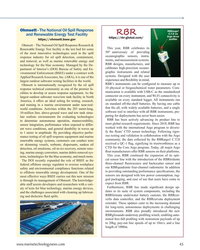 )
September 2023 - Marine Technology Reporter page: 45
)
September 2023 - Marine Technology Reporter page: 45Ohmsett - The National Oil Spill Response RBRargo³ C.T.D on RBR and Renewable Energy Test Facility Argo Arvor https://rbr-global.com/ pro? ler https://ohmsett.bsee.gov Ohmsett – The National Oil Spill Response Research & This year, RBR celebrates its Renewable Energy Test facility is the test
-
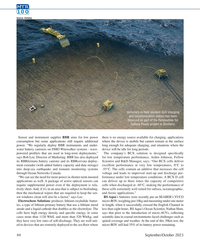 )
September 2023 - Marine Technology Reporter page: 44
)
September 2023 - Marine Technology Reporter page: 44MTR 100 Source: Verlume Verlume’s in-? eld resident AUV charging and communication station has been deployed as part of the Renewables for Subsea Power project in Scotland. Sensor and instrument supplier RBR aims for low power there is no energy source available for charging, applications consumption
-
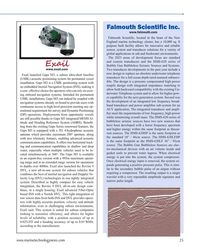 )
September 2023 - Marine Technology Reporter page: 25
)
September 2023 - Marine Technology Reporter page: 25Falmouth Scienti? c Inc. www.falmouth.com Falmouth Scienti? c, located in the heart of the New England marine technology cluster, has a 10,000 sq. ft purpose built facility allows for innovative and reliable sensor, system and transducer solutions for a variety of global applications in salt and
-
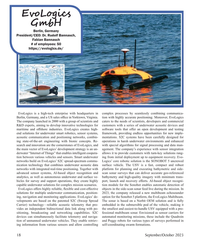 )
September 2023 - Marine Technology Reporter page: 18
)
September 2023 - Marine Technology Reporter page: 18EvoLogics GmbH Berlin, Germany President/CEO: Dr. Rudolf Bannasch, Fabian Bannasch # of employees: 50 https://evologics.de/ EvoLogics is a high-tech enterprise with headquarters in complex processes by seamlessly combining communica- Berlin, Germany, and a US sales of? ce in Yorktown, Virginia. tion
-
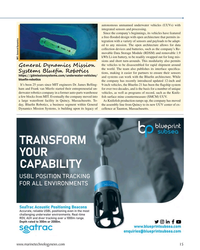 )
September 2023 - Marine Technology Reporter page: 15
)
September 2023 - Marine Technology Reporter page: 15autonomous unmanned underwater vehicles (UUVs) with integrated sensors and processing. Since the company’s beginnings, its vehicles have featured a free-? ooded design with open architecture that permits in- tegration with a variety of sensors and payloads to be adapt- ed to any mission. The open architect
-
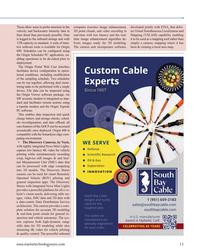 )
September 2023 - Marine Technology Reporter page: 13
)
September 2023 - Marine Technology Reporter page: 13These allow users to probe structure in the computer executes image enhancement, developed jointly with EIVA, that deliv- velocity and backscatter intensity data in 3D point clouds, and video encoding in ers Visual Simultaneous Localization and ? ner detail than previously possible. Data real-time
-
 )
September 2023 - Marine Technology Reporter page: 12
)
September 2023 - Marine Technology Reporter page: 12MTR 100 over Active Fluorescence (STAF) instruments, Chelsea is now at the forefront of practical measurements of phytoplankton photosynthesis, helping scientists understand the part that the oceans play in climate change as we look to achieve Net Zero. • Formed in 1978, EIVA provides software, equipment
-
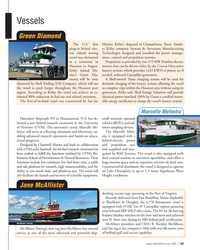 )
October 2023 - Marine News page: 43
)
October 2023 - Marine News page: 43Vessels Green Diamond The U.S.’ ? rst Marine, Kirby’s shipyard in Channelview, Texas. Anoth- plug-in hybrid elec- er Kirby company Stewart & Stevenson Manufacturing tric inland towing Technologies designed and installed the power manage- vessel was christened ment, control and propulsion systems.
-
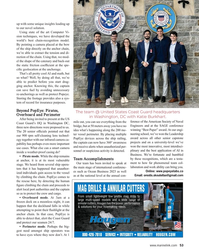 )
September 2023 - Maritime Reporter and Engineering News page: 53
)
September 2023 - Maritime Reporter and Engineering News page: 53up with some unique insights leading up to our novel solution. Using state of the art Computer Vi- sion techniques, we have developed the world’s best chain-recognition model. By pointing a camera placed at the bow of the ship directly on the anchor chain, we’re able to extract the tension and di- rectio
-
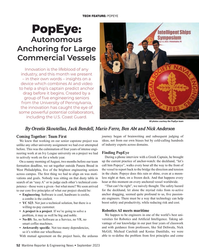 )
September 2023 - Maritime Reporter and Engineering News page: 52
)
September 2023 - Maritime Reporter and Engineering News page: 52TECH FEATURE: POPEYE PopEye: Autonomous Anchoring for Large Commercial Vessels Innovation is the lifeblood of any industry, and this month we present – in their own words – insights on a device which combines AI and video to help a ship’s captain predict anchor drag before it begins. Created by a
